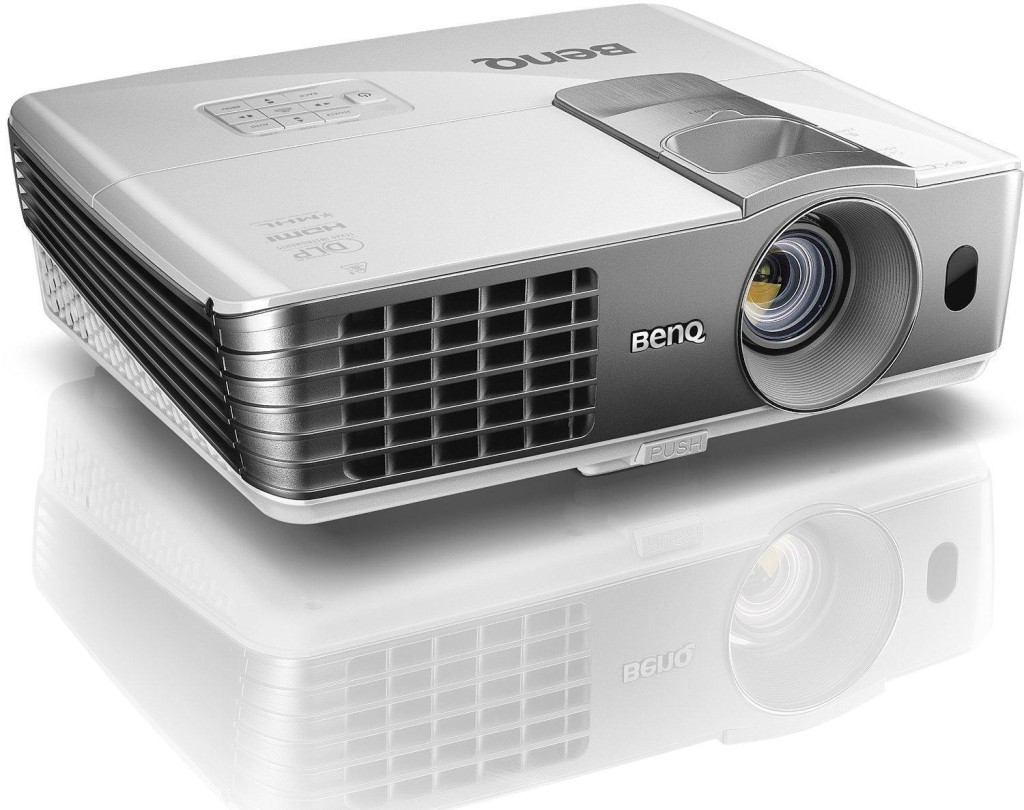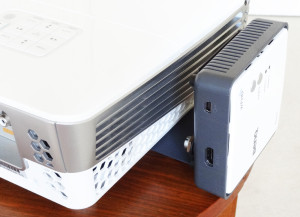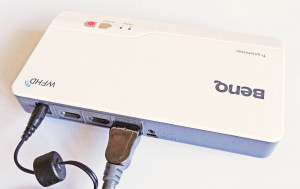 I still think the future of projectors lies with the cooler illumination technologies, LED and laser. But the hot lamp isn’t going anywhere any time soon: at the low end, prices for this class of DLP projector are coming down, while picture quality is quite visibly improving.
I still think the future of projectors lies with the cooler illumination technologies, LED and laser. But the hot lamp isn’t going anywhere any time soon: at the low end, prices for this class of DLP projector are coming down, while picture quality is quite visibly improving.
BenQ, an old hand in this sector of the market, is currently offering a model that’s a notch or two up on the now discontinued W1070, which was very well received at the 2012 launch.
I’ve been living with the W1070+ for a couple of months now, and here’s why I’m very impressed with it.
BENQ’S LATEST ENTRY-LEVEL PROJECTOR, the W1070+, does such a good job that I almost forgot to write “entry-level”. Yes, it really is that good.
Fishing around for niggles to balance my enthusiasm, the only really big issue I have isn’t with the machine itself, it’s with BenQ’s marketing department. And with a bunch of reviewers who have uncritically rubber-stamped BenQ’s assertion that this is a short-throw projector. This is not a short-throw projector.
A short-throw projector is one able to project an image whose diagonal is larger than the distance between the light source and the screen. Or in engineering terms, has a throw ratio smaller than unity. Short throw is great for lectures and business presentations because with the projector typically only a couple of feet away from the full-sized image the presenter won’t be shadowing the screen.
I would suggest that unless you’ve crammed the family into the smallest room in the house for their evening’s entertainment, or go in for professorial arm waving commentary on the art of film while they’re trying to enjoy “Pixels”, the last thing you need for home movie watching is a short throw projector.
The throw ratio of the W1070+ is quoted as 1.15 – 1.5 (a range, because this projector has a zoom lens). This is considerably greater than unity, although less than the typical 2:1 ratio that until recently was the norm for home entertainment projectors. These days there seems to be a tendency towards what it would be fair to call “reduced ratio” projectors designed with the smaller living room in mind. The W1070+ is a reduced ratio projector. In my own back room (where these things get rigorously tested with hours and hours of movie watching — a tough job, but someone’s got to do it) the W1070+ gives me a very nice large 100″ screen with the projector a little over 12ft from the wall. Yes, a blank wall is fine — dedicated screens of this size really aren’t worth the money unless you’re paying several thousand quid for a home cinema class projector.
A screw adjustment at the top of the projector gives you ±5% vertical lens shift — not much, but this is supplemented by a very flexible keystone adjustment (see boxout).
Keystone adjustment reshapes the image electronically to restore the rectangle. Unusually for a projector in this price range the W1070+ allows for horizontal as well as vertical keystone adjustment, meaning the projector can also be squinting sideways at the screen while still producing a rectangular image. A menu option displays a grid pattern to help you align the vertical and horizontal adjustment.
Keystone adjustment is deprecated by home cinema purists, who say it’s bound to degrade the image. A little, perhaps: but during my decade or so messing with projectors I can’t say I’ve ever been troubled with this.
The W1070+ is a 1080p DLP projector, and with the right source capable of producing an impeccably detailed picture. As with any projector, the colour quality will depend on light control in the viewing room. In daylight, with the screen in Bright mode, the 2,200 lumen display is excellent for business presentations. Even the small print (not that you’d be advised to use small print in a presentation) remains legible at this resolution.
But with daylight washing over the screen you will obviously lose the darker tones. Draw the curtains and switch to Standard mode, which will lower the brightness and create subtler colouring, also improving the detail in the murkier parts of the picture. I found this mode appropriate for TV watching in the daytime with the curtains drawn but with a certain amount of ambient light.
When you can create a really dark environment in the room, either with light-proof curtains or at night, there’s a third mode, Cinema. The projector itself is very disciplined about light spill, so this mode gives you the best chance of bringing out the detailed dark tones — depending on the quality of the source, of course. There are simple contrast and brightness controls to tune this to taste. And — another rarity for this class of projector — the remote control is illuminated so you can see what you’re doing in the dark.
To my eyes the picture quality in default Cinema mode is as good as I would expect from any projector costing up to a grand or more. But if you’re particularly picky the W1070+ gives you the option to tweak the hue, saturation and gain of each of the six primary and secondary colours on the colour wheel (red, green, blue, cyan, magenta and yellow).
The overall colour temperature can be also switched between Normal, Cool, Lamp Native and Warm, and you can even fine tune each of these to correct the grey scale, although you’d be advised not to mess with this unless you know what you’re doing and have the appropriate test instruments.
Modifications you make to any of the three Bright, Standard or Cinema settings can be stored in memory as two other settings, User 1 and User 2.
Input to the projector will typically be through HDMI, and two HDMI ports are provided, one of which supports MHL (multimedia high-speed link), allowing you to play video direct from any MHL-compatible phone if you have the right kind of connection cable. Legacy VGA, component and composite inputs are also provided to accommodate older source devices, and there’s also the standard 12v trigger connection to fire a drop-down screen (but see my remarks about screens and walls above).
As is usual with “home entertainment” projectors, the W1070+ has its own built-in mono sound system complete with speaker. What can I tell you? In an emergency, it works. But the quality of picture the projector provides deserves a lot better, and I strongly recommend you leave the sound to a decent hi-fi system. I’ve been testing recent projectors in conjunction with a Yamaha RX-V679 AV receiver I’m currently reviewing serially here, but even a very basic hi-fi set up will add so much more to your enjoyment than any projector’s built-in speaker can provide.
 3D
3D
Virtually every DLP projector you can buy these days provides 3D capability. It only has to be able to run the frames at twice the normal speed, alternating left- and right-eye frames while providing a way to keep the audience’s LCD glasses alternately blacking out the left and right lenses at the appropriate time.
More costly projectors provide this timing function through a separate wireless channel or infra-red channel, which of course adds to the price. Entry-level DLP projectors use an ingenious feature called DLP-Link, which does this through the picture shown on the screen and therefore needs no extra channel. A bright, almost instantaneous white flash interposed between frames is read by a receptor in the glasses, and this keeps the glasses and projector in sync.
The DLP-Link method adds almost nothing to the cost of the projector, and the receptor technology in the glasses costs peanuts, although this isn’t necessarily reflected in the prices charged by brand manufacturers. As I’ve mentioned before in these reviews, it’s well worth shopping around. I’ve more than once picked up brand new (but not brand name) DLP-Link glasses on eBay for around a fiver.
How does the W1070+ do on 3D? Readers will know by now that I’m not a fan of 3D, and I confess to leaving this section of the review until last. I discovered too late that the glasses BenQ provided for review were faulty (they wouldn’t charge through the miniUSB socket). These glasses aren’t bundled in the retail price and BenQ’s Web site lists them as €59, around £42. The eBay five quid ones I used instead were spex with very similar specs. BenQ’s glasses do come in a very nice box though.
Switching the projector to 3D mode kicks in the DLP-Link and brightens the image, because light will be lost through the glasses. The picture also takes on a pronounced red bias in the darker shades. The glasses correct this bias, so that the resulting image looks naturalistic (as far as 3D ever does), although a little darker than I would have liked. Because the projector — like others in this price range — lacks high-end electronic features like motion compensated frame interpolation some judder is occasionally noticeable, for example during panning of the 3D picture.
If 3D is your main fare you might like to look higher up the price range. For regular 2D viewing with the odd foray from time to time into 3D the W1070+ will serve you well.
Wireless
 The review unit arrived with a bolt-on kit that allows you to drive the projector wirelessly. Ironically, the kit introduces many more wires into the setup: wires to power and extract the HDMI signal from the receiver unit; wires to power and transfer video to the transmitter, and yet more wires to feed the optional extra IR blaster, which wasn’t provided — you’ll only need this if the projector is in a different room from the source.
The review unit arrived with a bolt-on kit that allows you to drive the projector wirelessly. Ironically, the kit introduces many more wires into the setup: wires to power and extract the HDMI signal from the receiver unit; wires to power and transfer video to the transmitter, and yet more wires to feed the optional extra IR blaster, which wasn’t provided — you’ll only need this if the projector is in a different room from the source.
A component was missing from the receiver mounting array, but luckily it was a standard camera mounting bolt so I was able to get the job done with a bit of improvisation. As you can see from the picture (my bolt’s visible to the left of the receiver’s HDMI socket) even with the right gear this attachment is never going to be elegant, and that’s before we’ve added the HDMI cable and the power cable (the USB socket in the picture) which can be run from one of the two USB outputs at the rear of the projector).
 The transmitter is powered from a bulky plug that contains the power supply unit, (which needed a Continental-to-UK adapter, adding to the general lumpiness of the kit) and allows for a total of three HDMI inputs.
The transmitter is powered from a bulky plug that contains the power supply unit, (which needed a Continental-to-UK adapter, adding to the general lumpiness of the kit) and allows for a total of three HDMI inputs.
The good news is that once you’ve rigged everything up physically it “just works”. The video signal fed into the transmitter appears at the remote projector with no need for pairing or tuning.
But I’m not at all sure where this wireless arrangement fits into the home entertainment scenario. If this truly were a “short throw” projector I can see why you may not want to run an HDMI cable from the source to a projector a mere foot or so from the screen. But you need to move the W1070+ back to at least 4 feet from the screen before you can even get a 48″ TV-size image. Perhaps it might be a handy option if you were ceiling mounting the projector as a permanent fixture, but you might prefer to spend the extra £250 to £300 that the wireless kit adds to the price on a better projector.
Not that it would be easy to find one. Putting the wireless kit to one side (as I was only too happy to do), this projector is a definite winner in the home entertainment category. Normally the arrival of a new version of anything presents a great opportunity for picking up the older model at a bargain price. With a recommended retail price for the new W1070+ at around £815 you might well be tempted by the older W1070’s drop to less than £550 on Amazon, with VAT and delivery thrown in. But it turns out Amazon’s offering this latest W1070+ model for over £200 off that RRP, at just a hair under £600, again including VAT and delivery. A bit of a no-brainer, really…
Chris Bidmead
